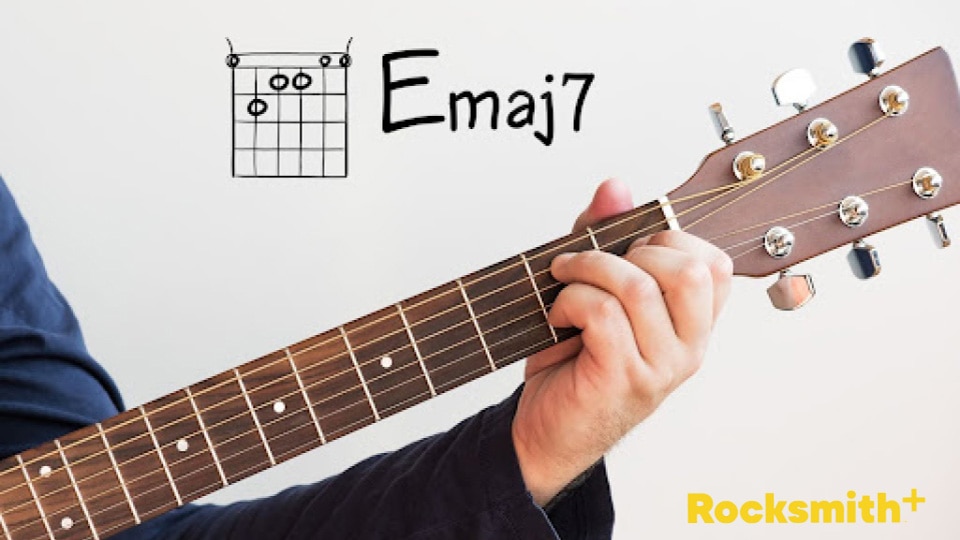The Emaj7 chord is a beautiful, warm chord, providing a rich harmony that is a staple in many genres of music, from jazz to pop, blues to rock. The dreamy sound of the E Major 7th chord has a way of tugging at our heartstrings, creating an ambiance that resonates deeply within us. But how can we harness this powerful chord in our guitar playing?
The secret lies in understanding and mastering the multiple ways to play Emaj7 along the fretboard. This article will guide you through four distinct methods, opening up a new world of musical possibilities for your performances.
What Is an Emaj7 Chord?
Let's begin by understanding what makes up the Emaj7 chord. In music theory, a Major 7th chord is comprised of four notes: the root, the major third, the perfect fifth, and the major seventh.
In the case of the Emaj7, these notes are E, G#, B, and D#. These notes come from the E Major scale, giving us that unmistakably full and resonant Emaj7 sound.
Major 7th chords hold a significant role in music. They are often used to create a sense of resolution or closure at the end of a musical phrase, imparting a soothing sense of satisfaction. Yet, they also possess a tinge of melancholy, making them versatile tools in the hands of a skilled musician. Understanding the underlying theory behind the Emaj7 chord allows you to utilize it more effectively in your compositions and performances.
1. Open Position Emaj7
The open position is a common starting point for beginners due to its relative simplicity. But don't be fooled - this position also provides a bright, resonant sound that even advanced players favor.
Here's how to position your fingers:
-
Start with the root note, E, which is the open sixth string.
-
Next, place your third finger on the second fret of the fifth string. This is the B note, the perfect fifth of the chord.
-
Your first finger goes to the first fret of the fourth string, creating the note D#, the major seventh of the chord.
-
Place your second finger on the first fret of the third string, creating the note G#, the major third of the chord.
-
Leave the second string open, creating the B note, the perfect fifth of the chord.
-
The first string, E, is played open to add the octave root.
Remember, strum from the sixth string, leaving out the first string if you prefer a less bright sound. This shape gives the Emaj7 chord a resonant, full-bodied tone and is excellent for rhythm playing or arpeggios.
2. Barre Chord Emaj7 At the 7th Fret
The barre chord version of Emaj7 brings a different texture to your playing and allows you to move the shape up and down the neck. It's played at the 7th fret, with the root note located on the fifth string.
Follow these steps:
-
Start by barring all the strings at the 7th fret with your first finger. This means you press down all the strings at this fret.
-
Your third finger presses down the 9th fret on the fourth string. This is your B note, the perfect fifth.
-
Next, your second finger lands on the 8th fret of the third string. This is the note D#, the major seventh of the chord.
-
Finally, your pinky finger stretches to the 9th fret of the second string, G#, which is the major third of the chord.
Strum from the fifth string and avoid the sixth string. The barre chord offers a versatile and compact Emaj7, suitable for songs where you need to switch chords quickly.
3. Emaj7 With Root on 6th String, 12th Fret
This shape of the Emaj7 chord has the root on the 6th string. The 5th and 1st strings are omitted for this shape.
Here's how you play it:
-
Your 1st finger is on the 12th of the 6th string, creating the root note E.
-
Then, skipping the 5th string, place your 3rd finger on the 13th fret of the 4th string, creating the D# note (major seventh).
-
Now, place your pinky finger on the 13th fret of the 3rd string, creating the G# note (major third).
-
Lastly, place your 2nd finger on the 12th fret of the 2nd string, creating the B note (perfect fifth).
While strumming, play all the strings except the 1st string. This rich-sounding chord is perfect for rhythm playing, best utilized with arpeggiated finger picking.
4. Emaj7 With Root on 4th String, 2nd Fret
This last version of the Emaj7 chord, with the root note on the fourth string, can be a little tricky but offers a unique sound texture that can add depth to your music.
Here's how to achieve it:
-
Your first finger should be on the second fret of the fourth string, playing the E note.
-
Use your third finger to barre the 4th fret from the 3rd string down, creating the B note (perfect fifth) on the 3rd string, the D# note (major seventh) on the 2nd string, and the G# note (major third) on the 1st string.
Remember to strum from the fourth string down when you play this version of Emaj7. It offers a high register sound that's great for both rhythm and lead lines, giving a smooth jazz vibe.
Practice Regularly
The Emaj7 chord, with its rich, jazzy sound, is a great addition to your chord vocabulary. By learning these four shapes, you've not only added a new chord to your arsenal but also taken a step towards understanding how chords can be manipulated and moved around the fretboard, enhancing your creativity and adaptability.
Remember to take it slow, practice regularly, and before you know it, you'll be playing these Emaj7 shapes effortlessly. Keep strumming, and enjoy the beautiful sounds your guitar can make!
For more than 6,000 songs to practice, perfect, and build your playing skills, check out the constantly growing library of music on Rocksmith+.
Sources:
How Chords and Key Impact Emotion in Music | The Music Studio
Root Notes in Music: How to Identify the Root of a Chord | MasterClass
7 Essential Strumming Patterns for Guitar (from Easy to Advanced) | StringKick
Barre Chords Explained! They're Super Easy! | Guitar Tricks Blog









